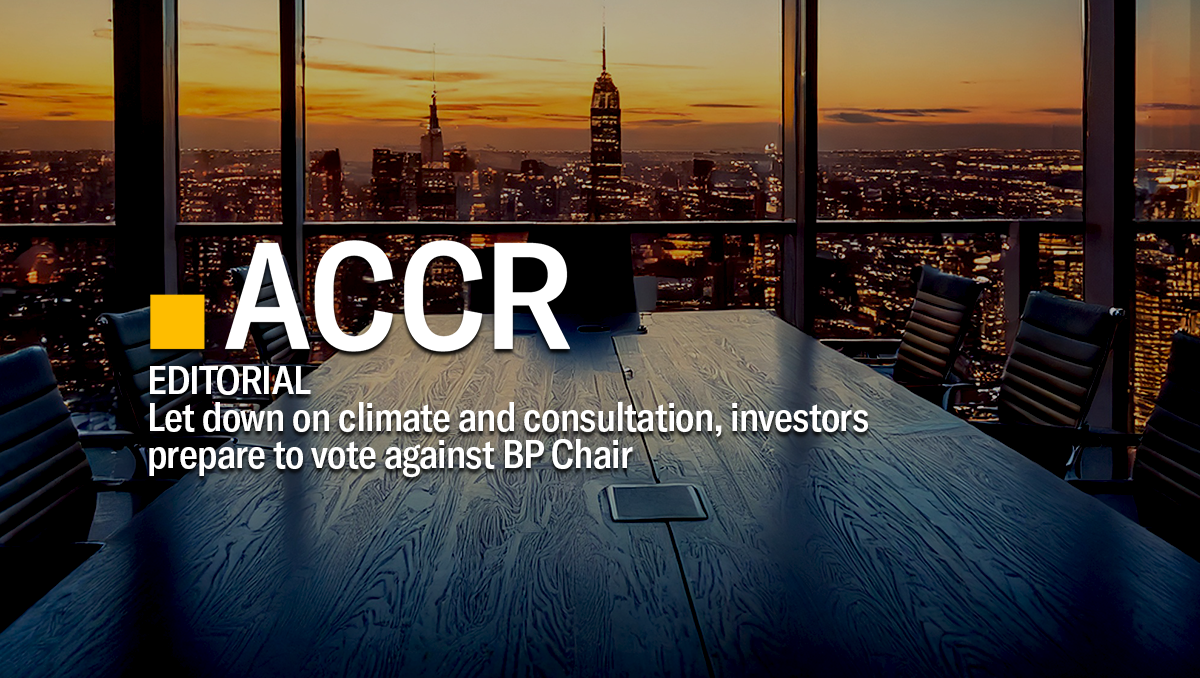Investor Insight Editorial: Let down on climate and consultation, investors prepare to vote against BP Chair
Nick Mazan, UK Company Strategy Lead
Despite attempting to jump before he was pushed, BP’s Chair is facing an almost certain backlash from investors at this week’s AGM, with investors concerned about the regression in the Company’s climate strategy leading the charge.
In the face of chronic underperformance and mounting pressure from shareholders, BP’s Chair, Helge Lund, recently announced he would be standing down, most likely to take effect in 2026. Yet his ticket remains on the ballot for this week’s Annual General Meeting, and it appears unlikely that his belated attempt to diffuse investor pressure will result in him emerging from the AGM with his reputation unscathed.
Top ten investor, Legal and General, has predeclared it will be voting against Lund, saying it is “deeply concerned” by BP’s regression on its climate commitments and its decision to not allow a Say on Climate (SoC) vote at the AGM. “We believe that climate change represents a financially material and systemic long-term risk to our clients’ portfolios,” said the UK asset manager.
Asset manager Robeco has also predeclared to vote against the re-election of the chair, as have UK pension funds Nest and Border to Coast Pensions Partnership. In February, investors with nearly £5 trillion in AUM sent a letter to Lund, calling on the company to update its approach to capital expenditure and provide a vote on the company’s energy transition strategy at this years’ AGM – none of which have happened. With no other obvious agenda items for these investors to express discontent, there is every possibility that a vote against the Chair will provide that vehicle.
BP’s “reset” of is strategy announced at the 2025 Capital Markets Day (CMD), which included a ramping up of oil and gas production and a slashing of renewables capex, does not appear to have satisfied investors. What is clear though, is that whatever the size of the vote against Lund this week, a material percentage will be from investors concerned about the threat to value from successive rollbacks on climate – and the lack of accountability to shareholders along the way.
It was only in 2020 that BP differentiated itself from its peers by putting forward a strategy to reduce its production of oil and gas by 40% by 2030. Despite this strategy being endorsed by a majority of shareholders at the 2022 AGM, BP dropped the target to 25% just a matter of months later – which resulted in a significant vote against the Chair at the 2023 AGM. The 2025 CMD announcement goes further still, with BP abandoning its production target and announcing it is increasing annual upstream capex spend to $10bn per annum, up from $8.5bn previously. All this without consulting shareholders.
Investors are rightly concerned about BP’s retreat from capital discipline on its upstream business. Over the past five years, BP allocated six times more capital to its upstream business compared to its much-scrutinised low carbon business, and yet it continues to underperform against the sector.
Increasing upstream capex now seems incoherent, as it increases the risk exposure to a sector in terminal decline. According to the IEA, there is no room for new long lead-time oil and gas investments in a Paris-aligned pathway (a pathway BP purports to be aligned with). It appears a high degree of recency bias may be at play at BP, given the exorbitant profits the sector has made over the past few years through the energy crisis. However, it is expected that oil markets are to be oversupplied in the coming years, and downward pressure on pricing is already coming through the system from multiple directions.
For a company claiming it wants to “reset”, capital discipline will be critical, and any capex going into expanding fossil fuel production should be heavily scrutinised. This means that as stipulated in the 2019 shareholder proposal – which was supported by management and over 99% of shareholders – BP needs to sufficiently demonstrate how each new capex investment is consistent with the goals of the Paris Agreement. To do this, the company needs to first show how each of its projects fits into the remaining carbon budget. Secondly, and only if the first condition is met, the Company must then prove how these projects are resilient through the energy transition by being at the bottom end of the cost curve.
At ACCR, we have done modelling to look at BP’s largest unsanctioned oil and gas projects that are expected to go through final investment decision before 2030. These projects are likely to correspond closely to the 20 new projects that the Company announced are to come online over that period. In this analysis, we show that none of these projects are consistent with the Paris Goals, and that, relative to peers, its oil and gas portfolio is more expensive than the median. This is particularly pronounced for the company's gas projects, all of which are more expensive than 60% of global unsanctioned gas projects. Pursuing any projects which fall within the third or fourth quartiles surely cannot be a disciplined approach to capital expenditure.
All its investors want BP to shake off its chronic underperformance problem, and while views on solutions may differ, increasing capital discipline is a possible point of convergence - which could mean a substantial vote against the Chair. We support a “no” vote, to signal concern about BP’s approach to capital discipline, in light of the Company’s plans to increase investment into fossil fuels.
